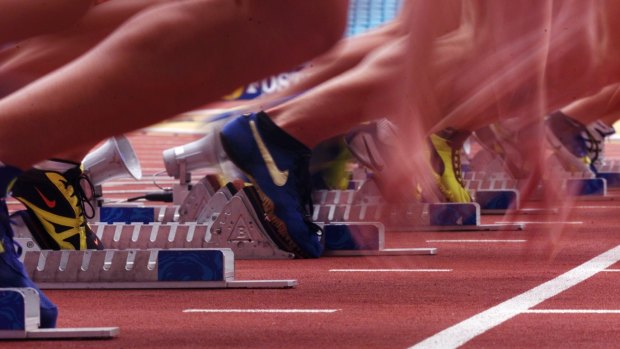- Analysis
- Sport
- Paris 2024
Why gene doping is the next great Olympic threat
When he stands on the blocks for the Enhanced Games, an Olympics-style event where performance-enhancing drugs are not only permitted but encouraged, Australian swimmer James Magnussen’s regime may include genome doping.
“At this point, I’m early in the process and still researching everything myself, plus getting medical advice, both individually and from the Enhanced Games,” Magnussen says.

Genome doping is harder to detect than the other forms of cheating.Credit: Dallas Kilponen
“If it has known applications with minimal side effects, that would definitely be something worthwhile looking into.”
While Magnussen is free to put whatever substances into his body he sees fit – he has previously stated, perhaps with his tongue only partly in his cheek, that he would “juice to the gills” in a bid to break the 50-metre freestyle world record at the controversial event – there are fears that athletes could secretly be genome doping at the Paris Olympics.
Former president of the World Anti-Doping Agency, Dick Pound, first raised the spectre of gene doping – which is illegal – more than two decades ago. However, not a single elite athlete has ever been caught doing it.
So what is genome doping? Is it secretly happening now? And what does it mean for the integrity of sport?

Professor John Rasko fears genome doping could be used to cheat at sport.Credit: Janie Barrett
These are questions we put to an authority on the topic, Professor John Rasko, AO, an Australian clinical haematologist, pathologist and scientist whose research focuses on gene and stem-cell therapy. A director of Cure The Future, a foundation that pioneers research into inherited diseases and cancers, Rasko’s passion is using gene therapies to cure individuals with diseases such as haemophilia and thalassaemia.
It’s a feat achieved when scientists manipulate cells by inserting viruses that have been stripped of genes that cause disease, which are replaced with ones capable of stopping it.
“The technology is now available to add genes to human beings and to their cells,” Rasko explains.
“These viruses are safe viruses. We’ve gutted them, we’ve modified them by removing all their disease-causing genes, using the tools of molecular biology and genetic engineering to render them safe.
“So they are safe and they only carry the genetic payload.”

Athletes could be genome doping in Paris and no one would know.Credit: Michel Euler
However, those same principles can also be used to give athletes an illegal edge. Instead of inserting genes that fight disease, it is now possible to alter a person’s DNA to enhance performance.
“If you wanted to game the system, and if you wanted to take part in unethical gene doping, some people have even adopted in their own kitchens some of these technologies – they call themselves biohackers,” Rasko says.
“You can even go onto YouTube and see these people injecting what they claim to be viruses … because they’ve been able to do home-brew genetic modification.
“If you take that to its furthest logical and scariest extremes, you could imagine that bad actors and indeed bad states might wish to harness these technologies that are widely understood and widely available for nefarious procedures, for bad procedures, for unethical procedures and introduce new genes into individuals that now for the first time may not be detectable.

It is now possible to alter an athlete’s DNA to enhance performance.Credit: Vince Caligiuri
“That’s where the real challenge is because it’s believed that it’s going to be a lot harder to detect gene doping than the other forms of doping that we are very familiar with, such as drug doping or blood doping.”
Nature and nurture still have their role to play, although genome doping could soon further blur the lines. Rasko gives the example of Eero Mäntyranta, a renowned Finnish cross-country skier, as having a natural genetic advantage. Mäntyranta won seven Winter Olympic medals, three of them gold, in three Games in the 1960s.
“He had a mutation in his EPO receptor that enhanced the production of red blood cells naturally,” says Rasko, explaining that it allowed Mäntyranta to maintain higher energy levels and stave off fatigue for longer than his competitors.
“So, was he a cheat? No way. He had a natural gift that he’d inherited. But it’s really interesting to reflect then: some people would say, let’s have open slather for all sports. If you do whatever you want, I’ll do whatever I want, and we’ll just fight on the basis of anything we can do.”
Rasko is vehemently against cheating in sport. But how do you stop athletes from utilising gene doping to try to give themselves the sort of edge Mäntyranta enjoyed?

Dick Pound warned about gene doping decades ago.Credit: AP
It’s a question that David Howman, the former boss of WADA, has long grappled with. Now working with the world athletics governing body’s Athletics Integrity Unit, Howman believes it’s only a matter of time before genome doping corrupts sport.
“It’s happening in society, therefore it won’t be forever that it’s not happening in sport,” Howman says.
“Gene doping is something that everyone has been alert to for two decades. No one has come up with an answer to it or any indication it has been used.
“There’s the devil you know and the devil you don’t know – and I don’t think we know this one very well ...
“The anti-doping community is having trouble detecting other stuff. It falls into the category of really hard. My worry is that when something is really hard, it’s not addressed.”
So if you wanted to genome dope, how would you do it?
“We could put into a person’s blood stem cells just like Mäntyrantah had as a way of enhancing red blood cells and that might not be detectable,” Rasko says.

The cheats are always on the cutting edge of science and the testers are forever trying to play catch-up.
“We could inject some of the genes like growth hormone, IGF, some of the genes that accelerate muscle performance that could conceivably enhance that, and it would be very, very difficult to detect.
“To be really clear, there is no one that we know of who has ever actually attempted gene doping, no one’s been caught.
“Many years ago there were a series of emails from a trainer that asked the question, ‘Where do I get some of this gene doping from?’, but it was never actually followed up.
“There were people pursuing the possibility of it, but it’s gone to ground.
“I don’t know whether anyone is pursuing it and, of course, one wouldn’t.”
Does Rasko think gene doping is happening in Paris?
“I have no reason to think that anybody has ever embarked on this unsafe or potentially dangerous attempt at cheating,” Rasko replies.
“However, I think I am naive and I don’t have the mindset of an elite sportsperson who might want to stop at nothing if they thought that it wasn’t able to be detected, and therefore they wouldn’t be banned for life potentially.
“But at the same time, could there be technologies that are developed that would be very difficult, if not near impossible, to detect, and yet offer some advantage?
“Yes is the answer. And that’s what WADA and others need to be very vigilant about.”
And so continues the battle to protect the integrity of sport. The cheats are always on the cutting edge of science and the testers are forever trying to play catch-up. Much of WADA’s current focus is on microdosing – where prohibited substances can leave the system in as few as six hours – rather than on the genome threat.
While the samples of Olympic athletes can be stored for up to 10 years, for most sports they are kept for no longer than three months. It leaves little time for the testers to develop the technologies required to catch those gaming the system.
“It’s a cat and mouse thing,” Howman says. “And often the mouse wins.”
For Olympics news, results and expert analysis sent daily throughout the Games, sign up for our Sport newsletter.